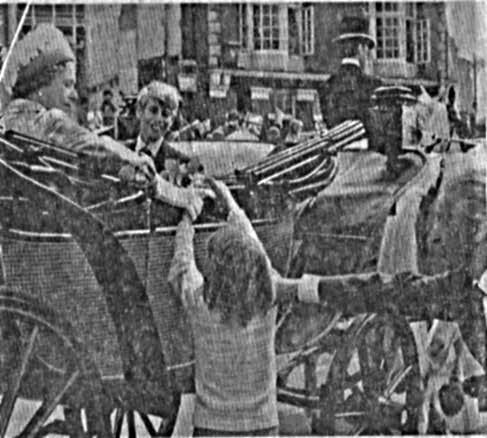
2 minute read
Memories of princes and pirates
AS the Coronation of Charles III approaches, Mike Jempson discovers some recent and older royal history hidden in a dusty batch of old newspapers at Glenside Hospital Museum.
THE Silver Jubilee visit of Queen Elizabeth II to Bristol in 1977 was big news.
Advertisement
The Bristol Evening Post, at the time claiming a daily readership of 400,000, ran a four-page ‘Royal Talkabout’ supplement in its August 8 edition.
It recorded the Queen’s visit to Portbury, where she opened the new West Dock. Her great-grandfather Edward VII had done the honours for Avonmouth Docks in 1908.
The royal entourage visited Fliton High School, and took a walkabout in a barely recognisable city centre.
Prince Edward, 13, was in the royal landau, but his older brother Andrew missed the trip as he was "staying on board the Royal Yacht with a heavy cold".
Church bells were rung throughout the city. Campanologist (bell ringer) William Coles, 72, from Mayfield Road in Fishponds, explained: "Years ago if the bells were not rung when the monarch passed by, the church wardens had to pay a heavy fine.
"Whether that still happens, I don’t know."
Williams' Big S store in Lodge Causeway cashed in on the occasion with a ‘Sovereign Sale’, offering 50% off Milady Kitchens complete with gold trim, and 30% off Bermuda Gas Boilers at £111.77, but taps were not included with their £76.52 coloured bathroom suites.
A 1985 Gazette Guide to Bristol reminded readers that the only reference to the city before the Battle of Hastings was when Bishop Wulfstan, favourite of King Ethelred the Unready (966-1016) berated Bristolians for their involvement in the slave trade with Ireland.
When William the Conqueror’s men arrived, they established an island fortress on what is now Castle Park.

Bristol’s importance as a major trading centre was assured when the river Frome was rerouted to join the Avon at Canons Marsh. For centuries, traders and explorers brought the city fortunes and infamy.
In 1552, 15-year-old Edward VI granted the Society of Merchant Venturers a Royal Charter - a licence to fill their coffers with the proceeds of lucrative expeditions to Pennsylvania and Virginia for tobacco, turning to smuggling when Charles I tried to make it a London monopoly.
They rebelled again when London sought to exclude other British ports from the hideous trade in African slaves. Exchanging guns, booze and shackles for men and women in West Africa who would be sold in the Caribbean if they survived the treacherous journey, Bristol merchants got rich on the return cargoes of molasses, sugar, rum, dyes and tobacco.
To protect their investments they remained neutral in the English Civil War, as the city changed hands between Roundheads and Royalists ostensibly under the command of the 15-year-old Prince of Wales, who would later become King Charles II.
Bristol merchants also financed privateers, or pirates, like Woodes Rogers who famously
With a home in Queen Square, which now has a blue plaque, Rogers was a notorious slaver and buccaneer, who not only received a ‘King's Pardon’ in 1718 from George I but was granted a pension and made governor of the Bahamas, being reappointed by George II in 1728 despite a tumultuous first term and bankruptcy.
But by the time George III signed the Bristol Dock Act in 1803, the city’s fortunes were in decline. The Venturers and Corporation joined forces to build the Floating Harbour, but mismanagement of the Bristol Dock Company and their harbour charges put Bristol at a disadvantage during Victoria’s reign. Even Brunel, hired to advise over silting and sewage in the harbour, found them unhelpful over his SS Great Britain.
*Glenside Hospital Museum is open on Wednesdays from 10am-1pm and Saturdays from 10am- 4pm. More details are available at www.glensidemuseum.org.uk
Extended versions of these columns can be found at www.mikejempson.eu.




